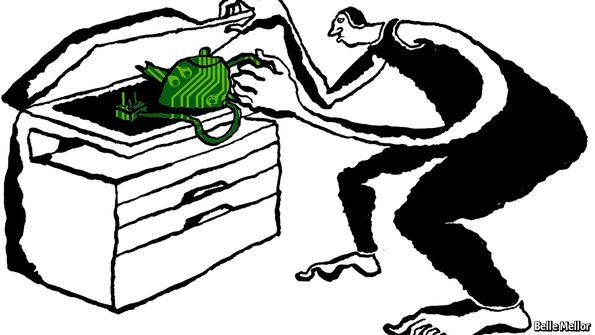Borrowing from photocopier technology, researchers find a way to make an electronics printer
Dec 24th 2014 | From the Economist
PRINTING has come a long way since Johannes Gutenberg perfected the commercial use of the printing press around 1439. Since then, movable type has given way to other processes, such as lithography and screen printing. In the digital era, laser and inkjet printers arrived. Then 3D printers emerged to make solid objects by building up layers of material. What would be nice is a machine that could also print the electronics that go into devices. Now one group of researchers has succeeded in demonstrating how just such a machine might work.
Although it is already possible to print layers of material to form some basic electronics, such as smart labels, these tend to be large and relatively unsophisticated compared with microchips made in a multi-billion-dollar fabrication plant. Some of Intel’s latest chips, for instance, contain transistors as tiny as 14 nanometres (or billionths of a metre). Making things this small allows hundreds of thousands of components to be squeezed onto a single chip.
Typically in the electronics industry, chips are fabricated in batches on silicon wafers. The wafers are then cut up and the individual chips packaged as components which are mounted, often by robots, onto circuit boards. The circuit boards are then installed in devices. Instead of doing things that way, a team at the Palo Alto Research Center (PARC) in California wondered about taking the individual chips as cut from the wafers and mixing them with a liquid to produce an electronic ink. The ink could then be used to print electronic devices directly.
Printing with “chips as ink” would provide two big benefits. The first is that the latest components from state-of-the-art fabrication plants could be used in the ink, which means high-performance devices could be printed. The second is that being a digital process driven by software, like 3D printing, an electronics printer would not rely on the economies of scale that rule most industrial processes. Just as each page of a document sent to a laser printer can be different at little or no additional cost, so too could the designs sent to an electronics printer. This is because software is easier to change than tools or production lines in a factory.
Electronic variety
All this means a single electronics printer could make lots of different things, cope with short production runs or knock out one-off prototypes without incurring a cost penalty. Such flexibility would be extremely valuable in product development and for specialist high-value, low-volume producers.
So much for theory. The practicalities are another matter. The big problem the team faced was to find a way to print tiny chips in the right places. To achieve this, they turned to an old idea: xerography. This is a technology used in photocopiers and was the basis for the creation of Xerox. It was made into a digital process when PARC, founded by Xerox in 1970 and now run as an independent research company, pioneered the laser printer.
Xerography relies on static electricity to position toner (a form of powdered ink) to form an image. A bright light is used to reflect a copy of a page onto a light-sensitive drum (or the image can be written onto the drum with a laser). An electrostatic field is generated in a way that makes toner particles selectively stick to certain areas on the drum to recreate the image. The image is then transferred to paper by rollers and fused with heat.
Toner particles only need to be in the right place, but chips must also be orientated correctly so they can be wired up. To achieve this, the researchers developed a way to induce a distinctive charge pattern on the surface of each chip. After being randomly spread on a surface, the chips are steered into their respective positions with an electrostatic field. They are then transferred to a final substrate with a roller. Depending on the application, they are wired up using photolithography or inkjet printing.
Ultimately, the intention of the PARC team is to have all these processes taking place inside a single machine. Just like a photocopier, people would then be able to use an electronics printer without having to know how it works.
From little acorns…
Such a machine is some way in the future. At their first attempt the researchers were able to print a device containing a grand total of just four microchips. It is not much to shout about, but it is enough to prove the concept of building an electronics printer that relies on xerography to construct functioning devices. The team is now working on printing devices with a greater number of chips and better accuracy. The researchers are also looking at possible applications which their process can be tried out on.
Janos Veres, who manages PARC’s printed-electronics team, says roles could include printing devices, such as sensors, directly onto components. This is something the aerospace and automotive industries are exploring. Another possibility is printing large display screens.
And it is not just processors and memory chips which could be mixed into ink, adds Eugene Chow, who manages the research project. Different electronic inks, like coloured inks in a paper printer, could be made containing piezoelectric, optical and even micromechanical devices. “This is a radical new tool,” says Dr Chow. “It has a long way to go but we think that it could have a huge impact.”

